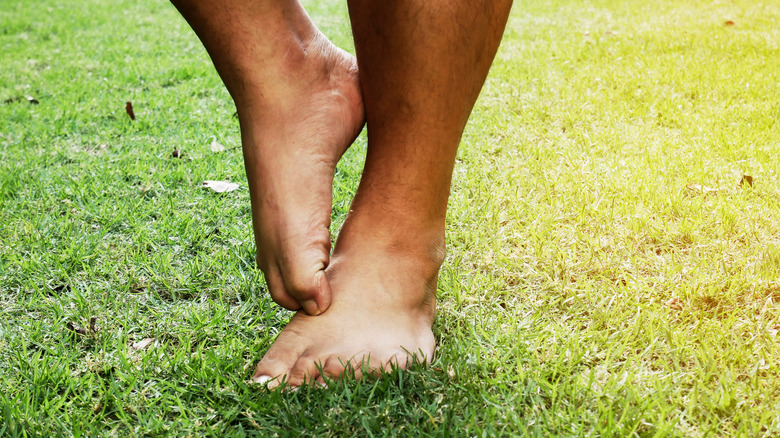Athlete's Foot Vs. Toenail Fungus: What's The Difference?
Fungal infections, also known as mycosis, are a common type of infection caused by fungi, which are a diverse group of organisms that naturally occur within the body, per the Cleveland Clinic. Fungi are not classified as plants or animals — instead, they are their own separate group of organisms with unique characteristics. Notably, there are millions of different types of fungi to be found, and while most are harmless to humans, there are some that can cause infections and diseases in various body parts, including the skin, nails, hair, and lungs, per Healthline. In general, fungal infections are relatively common and can affect anyone, from adults to young children and babies.
According to the Mayo Clinic, athlete's foot (also known as tinea pedis) and toenail fungus (also known as onychomycosis) are two common fungal infections that can affect the feet. While they share some similarities, there are also some key differences between the two.
How athlete's foot and toenail fungus differ
Toenail fungus is a fungal infection that affects the nails. It typically begins as a white or yellow spot on the nail and can cause it to become thick, discolored, and brittle, according to the Mayo Clinic. It is typically caused by a group of fungi called dermatophytes. On the other hand, athlete's foot is a fungal infection that usually affects the skin found between the toes and the soles of the feet (via Healthline). It can cause itching, burning, and blisters, and may result in peeling skin.
Notably, the key difference between athlete's foot and toenail fungus is their location. Athlete's foot primarily affects the skin, while toenail fungus affects the nails. Both conditions are contagious — infections are common in spaces where fungi can thrive, such as warm, moist environments (think locker rooms, showers, and swimming pools), per the Mayo Clinic. Toenail fungus and athlete's foot can also spread through direct contact with an infected person, according to the Cleveland Clinic.
How are athlete's foot and toenail fungus treated?
Antifungal medications are one of the most common treatments for athlete's foot and toenail fungus, per the Cleveland Clinic. Many mild cases of these infections can be treated using antifungal creams. However, prescription antifungal medications are generally more effective than over-the-counter options. These medications can be taken orally or applied topically, although topical options have a lower risk of side effects. More invasive treatments may sometimes be necessary for severe or persistent infections. For example, laser therapy can be used to treat toenail fungus by heating and destroying the fungus.
In addition to medication, some self-care measures can help manage the symptoms of athlete's foot and toenail fungus. For example, keeping the affected area clean and dry can help prevent the growth of fungi. Wearing clean, breathable, and moisture-wicking socks also helps prevent the spread of infection. If you use communal showers and swimming pools regularly, the clinic also advises wearing waterproof shoes or flip-flops.



